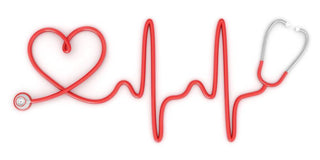Think you’re too young to worry about heart disease? Think again! From not smoking to exercising on a regular basis, the habits you develop now have a big impact on your cardiovascular health later in life.
Do you also believe that heart disease is not a women’s disease? This is a common misperception. Cardiovascular disease is the leading cause of death in women. In fact, each year more women than men die from this disease. You may also be surprised to learn that over ten times the number of women die each year from heart disease (including heart attack and stroke) than from breast cancer.†
The Go Red Campaign was created by the American Heart Association to dispel the myths and raise awareness of heart disease as the number one killer of women. You can support this cause by wearing red this Friday, February 3rd.
5 Things to Monitor at Every Age
The good news is that heart disease is largely preventable. In fact, a recent study showed that people who reach midlife without developing high blood pressure, diabetes or other risk factors for cardiovascular disease are much less likely to have a heart attack or stroke by age 80 than their less healthy counterparts.
Just by making some smart dietary and lifestyle choices each day and keeping track of a few numbers, you can ensure a vital cardiovascular system. These choices and numbers include the following:
Diet. Two-thirds of the adult population is overweight or obese. If you have excess weight, especially around the abdomen (waist measurement >35”), you’re more likely to have elevated blood pressure and high cholesterol, which increases your risk for heart disease and stroke. Body Mass Index (BMI) provides a reliable indicator of body fatness for most people and is a number calculated using a person's weight and height. A BMI of 25-29 is considered overweight; a BMI of 30+ is obese. A healthy BMI that you want to shoot for is 18.5 to 24.9.
Physical Exercise. Lack of physical activity is a risk factor for heart disease yet only a third of women regularly engage in exercise. With age, these numbers get even worse. Almost 40% of women aged 65 to 74 years and 55% of women 75 and older are physically inactive. You should aim for at least 150 minutes/week of moderate exercise or 75 minutes/week of vigorous exercise.
Not Smoking. We all know about the dangers of smoking. Still, almost twenty percent of women 18 years and older smoke cigarettes. Smoking or exposure to second-hand smoke raises your risk of heart disease. The carbon monoxide in cigarette smoke triggers plaque buildup in your arteries. By replacing some of the oxygen in your blood, carbon monoxide forces your heart to work harder, elevating your blood pressure. The nicotine makes your heart work harder by narrowing blood vessels and increasing your heart rate and blood pressure. Smoking also increases the risk of blood clots forming in your arteries. Even if you’ve smoked for years, the good news is that once you stop your risk of heart disease drops dramatically within one year.
Know Your Numbers. You probably know your height and monitor your weight on a regular basis. But, there’s a few more numbers you should be aware of and track:
- Blood pressure < 120 mg/dL (systolic); < 80mg/dL (diastolic)
- Fasting glucose < 100 mg/dL
- Total cholesterol < 200 mg/dL
- LDL or “bad” cholesterol < 130 mg/dL
- HDL or “good” cholesterol > 40 mg/dL men and > 50 mg/dL women
- Triglycerides < 150 mg/dL
High blood pressure is a major risk factor for heart attack and most importantly stroke. If you are obese, have a family history of high blood pressure or are African-American you have an increased risk of developing hypertension. Adults should have regular blood screenings at least every two years; more frequently if your numbers are not ideal or if you have other risk factors for heart disease.
High blood cholesterol is a major risk factor for cardiovascular disease and increases the risk of stroke. High levels of LDL raise the risk of heart disease and heart attack. High levels of HDL benefit the heart and lower your risk for this disease. HDL level may be a stronger risk factor for developing heart disease in women than in men. Adults should have their cholesterol measured at least once every five years starting in their 20s; more frequently if your numbers are not ideal or if you have other risk factors for heart disease.
Higher triglyceride levels often go hand-in-hand with higher total cholesterol and LDL cholesterol numbers. Research suggests that high triglyceride levels may be more of a risk for women than men.
Know Your Family History. If you have a close relative that has had a heart attack or stroke, you may be more at risk for developing heart disease. Your risk increases if your father or brother had heart disease before age 55 or if your mother or sister was diagnosed with heart disease before 65 years of age.
Now that you’re familiar with the five areas that influence cardiovascular health, below you’ll find specific actions to take during your 20s, 30s, 40s and beyond. While your priorities may change with each passing decade, you should monitor these five areas to ensure a vital cardiovascular system.
A Healthy Heart For Every Decade
Now that you’re familiar with the five areas that influence cardiovascular health, below you’ll find specific actions to take during your 20s, 30s, 40s and beyond. While your priorities may change with each passing decade, you should monitor these five areas to ensure a vital cardiovascular system.
What are the chances that you’ll develop heart disease in the next 10 years? Get your estimated risk now with Mayo Clinic's online tool.
†In 2013, the latest year for statistics, nearly 300,000 women died from heart disease whereas around 40,000 women died from breast cancer.
Last updated May 4, 2018

